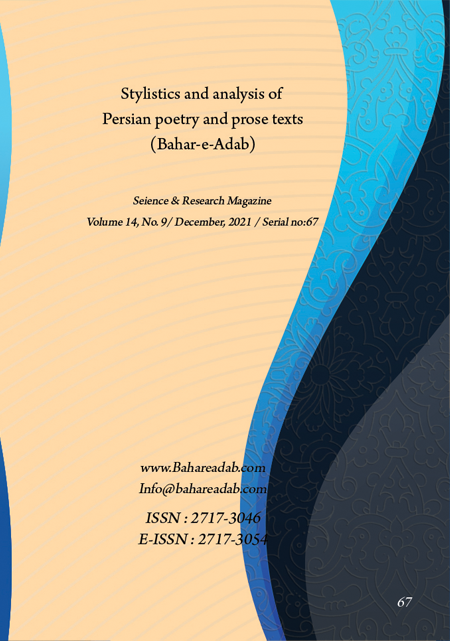- Count View : 266
- آدرس کوتاه شده مقاله: https://bahareadab.com/article_id/1172
- کد doi مقاله: Doi: 10.22034/bahareadab.2021 .14 .5567
Journal of the stylistic of Persian poem and prose
volume Number 14،
number In Volume 9،
،
issue Number 67
An intertextual study of the adolescent novel "Mahan Nightmare" by Majid Shafiei
Farzaneh Monesan (Author in Charge), Ali Safaei
Abstract
BACKGROUND AND OBJECTIVES: Intertextuality is one of the techniques that can help to create new novels based on ancient texts. Intertextual studies are among the important approaches in contemporary literary research, according to which every literary text is a retelling and reproduction of previous or contemporary literary works. Majid Shafiei, one of the leading writers in the field of children and adolescents in the country and winner of several literary awards, is among those who have turned to this literary format. The novel "Mahan’s nightmare", written by Majid Shafiei, seeks to apply new method in narration and avoid traditional methods based on the intertextuality.
METHODOLOGY: The present research is a theoretical study with the library method whose extent and study population include Nezami’s Haft Peykar and Mahan’s nightmare.
FINDINGS: The findings of this study show that the theme of anti-oppression and avarice in the two stories and the symbolic use of light versus darkness are common concepts, and applying color and light with its high frequency, has strengthened the intertextual aspects in Mahan’s nightmare.
CONCLUSION: It is being conclude that Shafiei has used explicit-intentional and implicit intertextuality based on Haft Peykar in Mahan’s nightmare, and has also applied storytelling techniques and common concepts.
Keyword
Explicit intertextuality
, implicit intertextuality
, Nezami’s Haft Peykar
, Mahan’s nightmare
, Majid Shafiei
- Abrams, M.H. (2005). A Glossary of Literary Terms. Saeed Sabzian (trans), Tehran: Rahnama, p.43.
- Allen, G. (2010). Intertextuality. Payam Yazdanjoo (trans). Tehran: Markaz, p. 142.
- Amin Razavi, M. (1998). Suhrawardi and the school of Illumination. Majdoddin Keyvani (trans). Tehran: Markaz, p.106.
- Bahar, M. (1996). A Research in Persian Mythology. Tehran: Agah, p. 40.
- Chandler, D. (2007). Semiotics: the basics. Mehdi Parsa (trans). Tehran: Soureh Mehr, p. 283.
- Dad, S. (2006). Dictionary of Literary Terms. Tehran: Morvarid, p. 219, pp. 229-331, pp. 423-424.
- Farhangkhah, M.R. (1997). The Devil in Literature. Mehdi Ahmadi (ed). Tehran: Payam, p. 23.
- Itten, J. (2003). The Art of Color. Arabali Sharveh (Trans). Tehran: Yasavoli, p. 201.
- Luscher, M. (1991). The Luscher colour test. Leila Mehradpei (trans). Tehran: Hesam, pp. 77, 87.
- Mirsadeghi, J. (1988). Story Elements. 2nd ed. Tehran: Shafa, pp.93-94.
- Moein, M. (1985). Moein Encyclopedic Dictionary. 1st Vol. Tehran: AmirKabir.
- Namvar Motlagh, B. (2008). Transtextual Study. Human Sciences, No. 56‚ pp.136-137.
- Nezami, E. (2000). Leyli and Majnun. Tehran: Hozeh Honari.
- Nezami, E. (2014). Haft Peikar. Tehran: Ghoomes.
- Sabbaghi, A. (2013). Comparative Study of Three-dimensional Intertextuality of Gennete and parts of Islamic Rhetoric Theory. 9 (38), pp.59-72.
- Schimmel, A. (2010). The Mystery of Numbers. Fatemeh Tofighi (trans). 2nd ed. Tehran: University of Religions and Denominations press, pp.163, 166.
- Shafiei, M. (2013). Mahan’s Nightmare. Tehran: Institute for the Intellectual Development of Children and Young Adults.
- Sohravardi, S.Y. (1993). Oeuvres philosophiques ET mystiques. Tehran: Institute of cultural studies, pp. 106, 113

